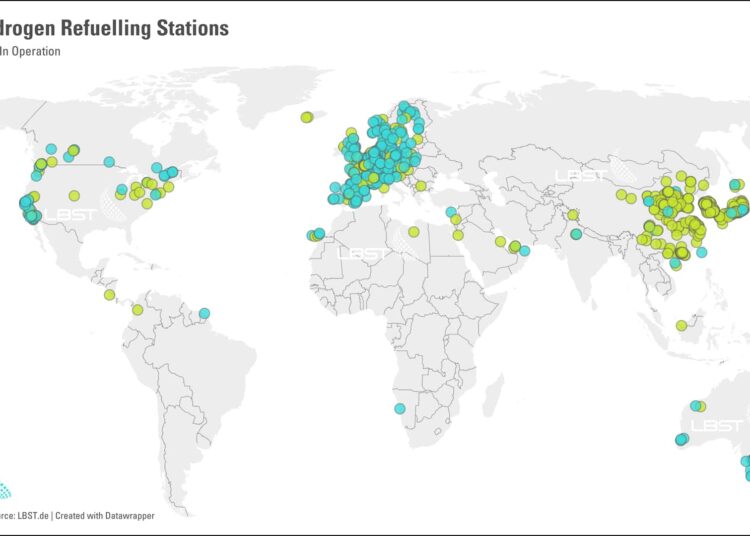In 2024, around 125 new hydrogen refuelling stations were opened worldwide: 42 in Europe, around 30 in China, 25 in South Korea, 8 in Japan and 13 in North America. This is the result of an analysis by H2stations.org. 45 countries now have a hydrogen refuelling infrastructure in operation or under construction. However, by the end of 2024 there were only 1,160 hydrogen refuelling stations in operation worldwide.
Of these, 748 were in Asia, with China leading the way with 384 stations. South Korea had 198 refuelling stations, while Japan had 161 refuelling sites. By comparison, the hydrogen infrastructure in Europe is still sparse: at the end of last year, there were only 294 refuelling stations, most of them in Germany: 113 refuelling stations. France was second in Europe with 65 refuelling stations, followed by the Netherlands with 25 and Switzerland with 19.
Photo by: H2Stations.org
Hydrogen refuelling stations in Europe: high concentration in the small Netherlands, but most in Germany
The hydrogen network in North America is even less developed. In Canada, the world’s second largest country by area, the number of refuelling stations for fuel cell vehicles increased by four to twelve last year. In the USA, nine new stations were opened, but twelve were closed, bringing the total to 89. By far the largest number, 74, were in California.

Photo by: H2Stations.org
Hydrogen refuelling stations in North America: the density of the network is very low, only California is well supplied
The first hydrogen refuelling stations have been opened in the capitals of Bulgaria and Slovakia. New to the list of countries with operational hydrogen refuelling stations is New Zealand.
The world’s 1,160 hydrogen refuelling stations could soon be joined by more. There are concrete plans for at least 377 more refuelling sites outside China. However, there is some uncertainty about the actual number of refuelling stations. One reason for this is the lack of announcements about closures.

Photo by: H2Stations.org
Hydrogen refuelling stations in Germany: there are apparently the most in the west of the country
The maps are based on data from LBST GmbH, in which TÜV Süd is the largest shareholder. LBST is a sustainable energy and mobility consultancy. LBST’s own website, H2stations.org, claims to provide the most comprehensive overview of all hydrogen refuelling stations in operation, planned or decommissioned. H2stations.org also provides maps. Commercial users include navigation service providers and industrial customers from sectors such as automotive, gas and infrastructure providers.

Photo by: H2Stations.org
Hydrogen refuelling stations in Asia: China, Japan and South Korea are leading the way
The bottom line
The hydrogen efforts of Hyundai, Toyota and BMW are reminiscent of the small village of the indomitable Gauls around Asterix. The vast majority of experts now believe that battery-electric mobility will prevail for cars, while hydrogen is more likely to be seen as an energy source for aircraft or, at best, trucks.
One of the reasons for this, in addition to low efficiency, is the low density of refuelling stations, as the new H2stations.org map clearly shows. The network is already sparse in Germany and virtually non-existent in other countries, such as the US outside California.
Read the full article here



























Discussion about this post